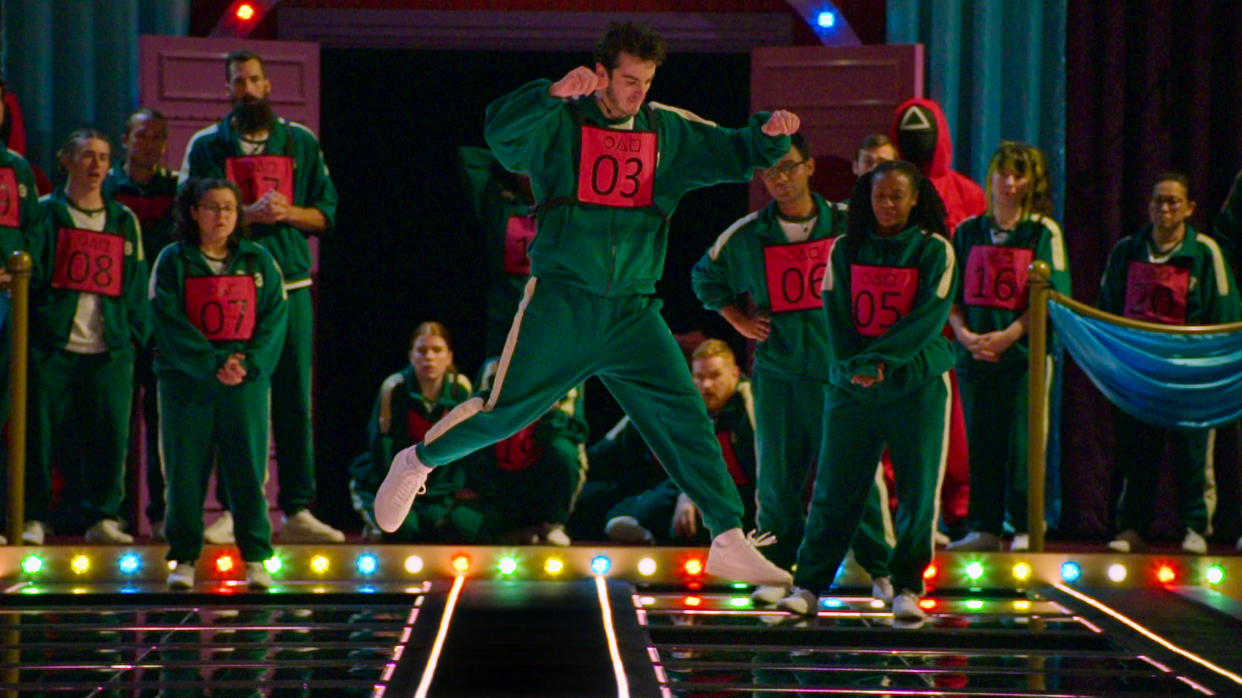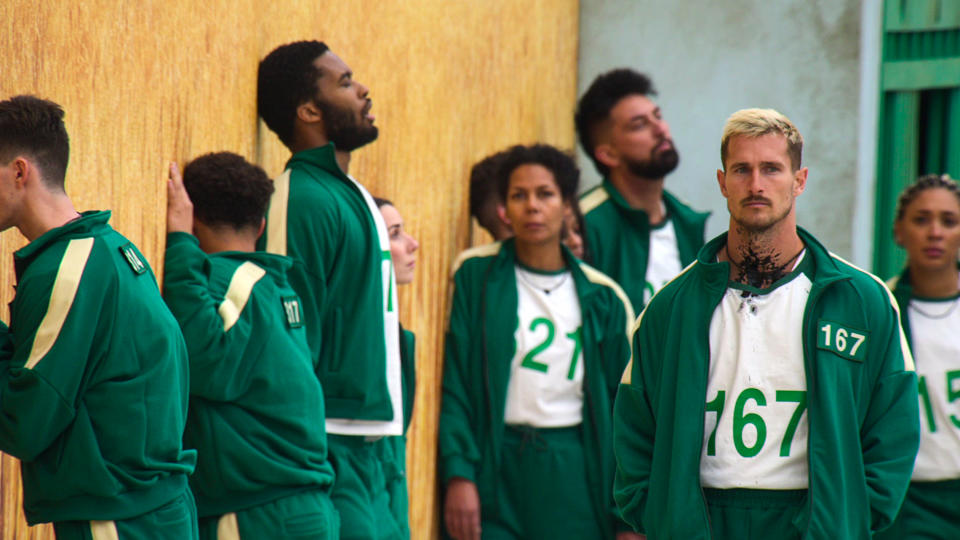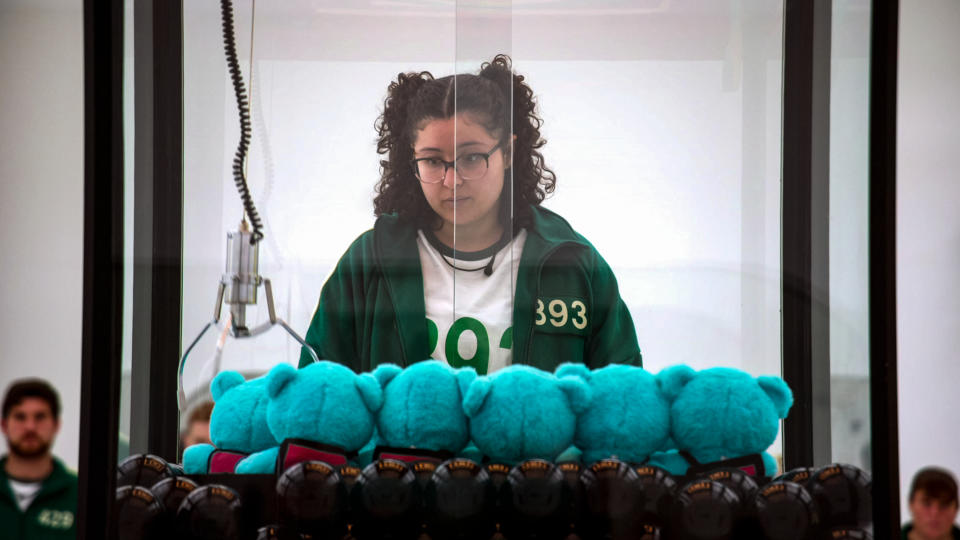Child’s Play? Hardly — 1 ‘Squid Game’ Challenge Required 9 Months of Development

- Oops!Something went wrong.Please try again later.
- Oops!Something went wrong.Please try again later.
“Squid Game: The Challenge” has to literalize, at human scale, the games the original Hwang Dong-hyuk series takes an (understandably) limited, narrative perspective through. It’s both a production design and game design problem to solve: How much space do 456 people need to play a game of red light/green light? How can you build a glass bridge that’s safe enough to jump on but high enough to hurl into an abyss the players who fail?
Even the smallest details — like creating a Dalgona cookie recipe that was of a uniform thickness and consistency — took almost 20 tries to get right. But the way that “Squid Game: The Challenge” realizes its games is also illustrative of how all reality game shows organize their challenges and the qualities that make them so appealing to watch.
More from IndieWire
Ridley Scott's Multiple Cameras Gave Us Joaquin Phoenix Grunting Like a Pig in 'Napoleon'
'Beef' Creator Lee Sung Jin Breaks Down Resonance of Netflix Hit - and Best Fan Response
Some of the “Squid Game” challenges weren’t possible to pull off in real life or needed to be structurally rethought. It’s not that Glass Bridge is done almost wholly in VFX in the original narrative series that makes it hard, according to “Squid Game: The Challenge” game designer Ben Norman. It’s that the difference between safety glass and sheet glass can be easily seen by the naked eye, so in reality, the contestants wouldn’t have any doubt about where to step.
“We had to develop a system that made every pair of panels look the same and be safe so that no player could work out the route across the bridge. Our solution was 17 pairs of clear Perspex trap doors that give the appearance of glass and evoke the same feeling of jumping on them while being 100 percent controllable by us,” Norman told IndieWire.
But even when the glass is controllable, that doesn’t mean the games are. Norman said that the challenges evolved significantly in testing, both in terms of the physical design and the rules, in order to maximize drama and achieve consistent results. Norman and his team initially tested games that were easy to play in the real world like Red Light/Green Light and Marbles. From small groups, they worked out a rough sense of how much space was needed and the timing of each round.
“[For Red Light/Green Light], we initially worked out how much distance could be covered by a person during one round of the doll singing. We then figured out how many rounds would be needed to make the game last, then we multiplied these two numbers by 456 players to give us the optimal size for the game’s space,” Norman said. “Once we had found a studio big enough, it was then time to work with our games tech company to develop a movement detection system that could detect 456 players making the tiniest of movements simultaneously across a big area. This was not an easy process and took nine months of development.”
Norman had to scale up the detection system from a small field with a handful of players to the 328 feet by 131 feet studio space the game ultimately took place in; because the show does not follow a set protagonist through the game, the way the narrative series captured players’ reactions, they had to cast a wide net; a number of players were randomly assigned individual mics to wear while Atmos mics and cameras were placed around the room to pick up additional voices and reactions.

But testing and iterating on game designs are just as crucial at smaller scales, too. “Survivor” challenge producer John Kirhoffer told IndieWire that tribal and immunity contests can take weeks and sometimes months of testing to get right.
“Whether it is a physical or mental challenge, we do extensive internal testing with our core challenge team and art department staff (the folks who build them generally love to test them…mud elements notwithstanding),” Kirhoffer said. “We then bring on the Dream Team to test them — and often for puzzles, word games, and brain teasers, we will also bring in producers, accountants, medical staff, and anyone who is up for it. When we feel the new element is solid, we then test and rehearse them with Jeff for the final sign-off and any additional fixes.”
Challenges are also a huge collaborative back and forth between producers, designers, and the art department. “On many occasions, we have had the best-laid plans, but local supply shortages in building materials have proven to be stressful,” Kirhoffer said. Notably in Gabon, the challenge team’s plans for huge wooden obstacle courses ended up needing to be much slimmer “bush poles” stuck in the ground against the natural terrain — although Kirhoffer noted that audiences seemed to enjoy the pole challenge just as much.
“In the past several years we have begun to share all of our ideas with [the art department] before we pitch anything to Jeff, so that they can mitigate problems or resource issues we may have missed,” Kirhoffer said. “Often we will ask for a puzzle or prop that they don’t think is as good as it could be, and they will just say, ‘Leave it with us mate,’ and bam! We have a beautiful hanging tuna puzzle or massive half-pipe wall climb that is so much better than we had planned.”

Resources were also a motivating factor for the “Squid Game: The Challenge” team. “Our biggest hurdles with such large player numbers are prop repeats. Sourcing props in such large quantities means that you often have to source straight from manufacturers,” Norman said. But wholesale prop gathering requires the kind of lead times that TV schedules don’t often allow for, so in order to nail the look of the original “Squid Game” tasks, if the production team couldn’t buy the right amount of something, they’d have to make enough from scratch.
“In some cases, we hadn’t finalized some of the game ideas before the sets were designed and construction had started, so we would reverse engineer it and design our games to fit within the parameters of the space,” Norman said.
That kind of adaptability is an important pillar of game design, especially for a show where players know (or think they know) some of the challenges that are in store. “Survivor” has been running long enough that there is a set structural logic to the overall blend of challenges. “We begin each season with bigger more physically aggressive tribe challenges, while there is a tribe, and tribe-mates, to lean on. After the merge it becomes crucial that all immunity challenges are as fair as possible for each individual,” Kirhoffer said.
But even knowing that there will be big setpieces for the opening, merge, and finale, Kirhoffer relishes the chance to structure challenges that surprise the players. “For me, the main characteristic that makes for a great reality competition is uncertainty. Not knowing who may win on any given day is so dramatic. That is why we mix up the types of elements from episode to episode,” Kirhoffer said. “Is the emphasis on balance, strength, speed, swimming, communicating, puzzle solving, individual heroics, or teamwork? I love live sports, and I still consider it an incredible privilege to have a front-row seat at every ‘Survivor’ challenge. They are still so fun for all of us who make them.”
What’s also fun for both Kirhoffer and Norman is the chance to push the limit on the scale of challenges. “As we began merging with more and more players over the years, [that added] more drama and higher stakes for the show. It also added a new level of challenge for us. The math is simple: more people require more challenge lanes and more elements,” Kirhoffer said. “We need to balance the intricacies of those elements depending on how many people are playing and the resources and time we have available.”
“It’s definitely opened my eyes to what’s possible with some clever game ideas and a decent amount of time and money to develop them,” Norman said. “Anything is possible.”
Best of IndieWire
Sign up for Indiewire's Newsletter. For the latest news, follow us on Facebook, Twitter, and Instagram.

